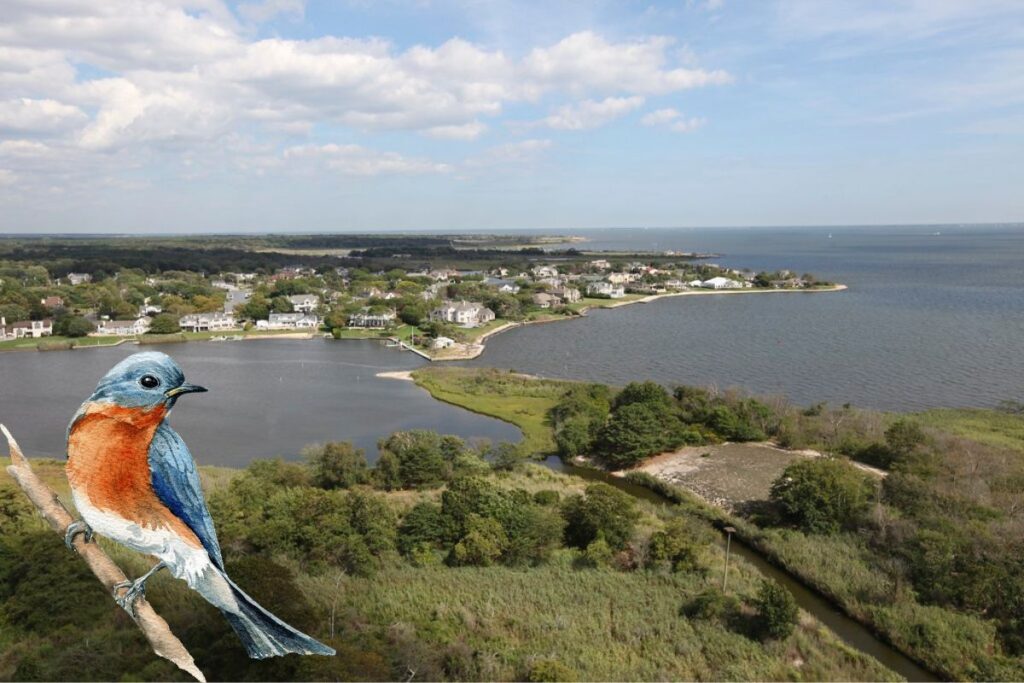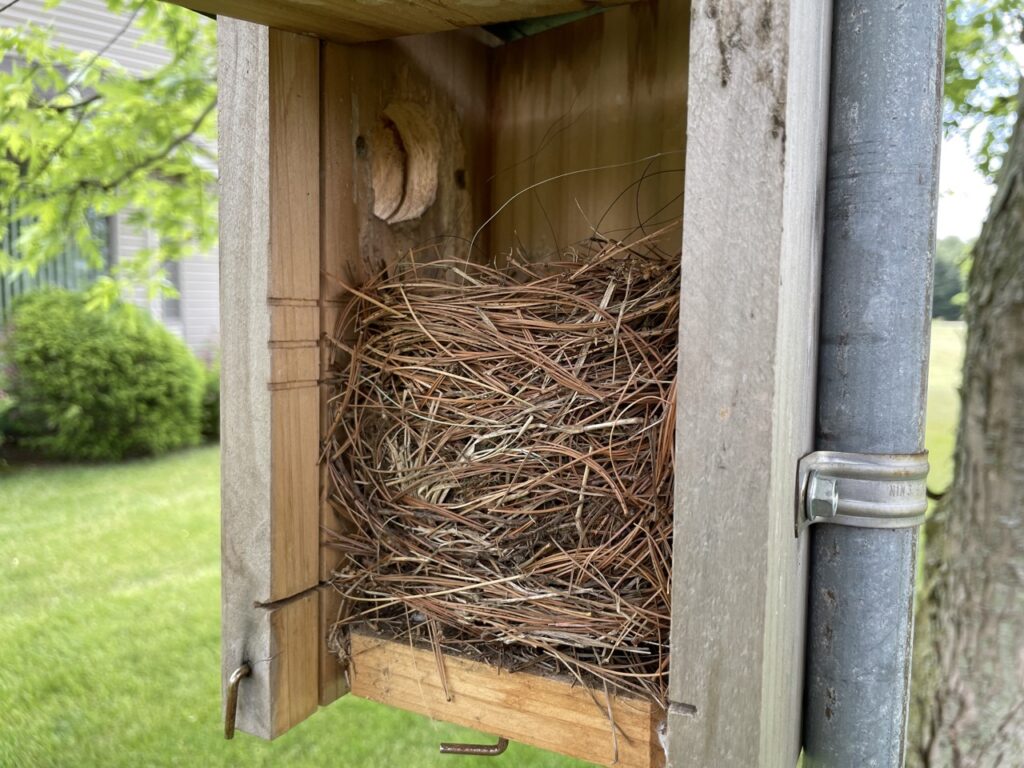
Bluebirds are one of the most beloved songbirds in the United States. The beautifully blue plumage on their backs and friendly disposition make bluebirds a joy to observe. The Eastern Bluebird species finds its home all over the eastern half of the United States, but sometimes they can be difficult to find. Even though the Eastern Bluebirds in New York’s state bird, many people wonder: are there bluebirds on Long Island?
Bluebirds on Long Island, New York
There are bluebirds on Long Island. The population of Eastern Bluebirds reportedly increased by 300% between 2001 and 2012. You can find bluebirds in many rural and agricultural areas, as well as in nature preserves like Tiffany Creek Preserve, Upland Farms Sanctuary, and Robert Cushman Murphy County Park.
The 300% Eastern Bluebird population increase between 2001 and 2012 was noted by the Shelter Island Reporter in this 2013 article.
Due to agricultural changes and pesticide use, the bluebird population on Long Island had almost disappeared by the 1970s. Thankfully, things have turned around since then. Many golf course managers, vineyard owners, and nature preserve staff have been responsible for the increasing Long Island bluebird population. Putting up wooden nest boxes for bluebirds to use has played a great part in the growing numbers.
In this article, we will discuss why bluebirds almost disappeared from the island and what has led to their comeback. We’ll also mention the best places to spot these birds on Long Island and how you can attract them to your own back yard. Bluebirds are on Long Island, and they are a birdwatcher’s best friend!
The Disappearance and Reappearance of Bluebirds on Long Island
The Decline of Bluebirds
Eastern Bluebirds started to decline in numbers around the 1970s in New York, similar to the rest of the country. There are three main reasons for this decline.
First, bluebirds thrive on a diet of insects that they hunt in short grass and open fields. Widespread pesticide use on lawns and fields in the latter half of the 20th century made it harder for bluebirds to thrive like they once did.
Secondly, bluebirds are secondary-cavity nesters, which means they build their nests in holes in dead trees and in rotting wooden fence posts. Without thinking about it, removing dead trees from properties and replacing wooden fence posts with metal ones led to fewer nesting spots for bluebirds.
Third, bluebirds started to face fierce competition from two invasive bird species: the House Sparrow and the European Starling. What few nesting locations bluebirds could find were often taken from them by the more aggressive sparrows or the larger starlings.
With these three factors occurring relatively in unison, eastern bluebirds began to decline in numbers on Long Island, until they almost disappeared entirely. The East Hampton Star recalls that “[b]y the mid-1980s there were only a few pairs of locally nesting bluebirds” in the area.
The Resurgence of Bluebirds
Fearing that bluebirds would disappear altogether, at this time, many concerned Long Island residents began erecting wooden nest boxes for bluebirds to use. Many people started similar nest box projects across the country at the same time, thanks to the work of the North American Bluebird Society.
Fast forward to the 21st century – wooden nest boxes and less pesticide use started making a very noticeable impact on the bluebird population on Long Island. Shelter Island Reporter noted the following in 2013:
Twelve years of providing nest boxes for Eastern Bluebirds at Mashomack Preserve have helped increase the Shelter Island bluebird population by over 300 percent from 2001 through 2012. Many who rarely or never had seen a bluebird now see them in the meadows of the preserve routinely.
Shelter Island Reporter

3 Verified Places to See Bluebirds on Long Island
Tiffany Creek Preserve (Nassau County)
Bluebirds have been spotted at Tiffany Creek Preserve since at least 1995 (source). There are examples of bluebirds taking refuge there when a housing boom displaced the birds from multiple other locations on the island. The mix of forest, hills, and meadow on this nature preserve provide bluebirds with plenty of ideal habitat. Nest boxes have also been erected on the preserve to provide homes for bluebirds and other native, cavity-nesters.
Upland Farms Sanctuary (Cold Spring Harbor, NY)
This former dairy farm-turned nature preserve on Long Island is the happy home to Eastern Bluebirds in the spring and summer (source). The mix of walking trails, trees, meadows, and preserved land make for the perfect environment to accommodate bluebirds.
Robert Cushman Murphy County Park (Manorville, NY)
Avid birdwatchers have often spotted Eastern Bluebirds at this preserved parkland on Long Island (source). While bluebirds don’t delve far into the forest, they are easy to find hunting for insects just outside of the forest, near the paths and open fields.
A common trait among all of these properties is that there is ample space and wide-open areas for bluebirds to hunt for insects. Luckily, you can create this same environment in your own back yard if you have a little bit of space.
How to Attract Bluebirds to Your Yard on Long Island
If you are interested in attracting bluebirds to your property on Long Island, all you will need is an open, grassy area in your yard, and a spot where you can set up a nest box (this can be in the corner of your yard overlooking the open space).
For Eastern Bluebirds, I recommend using my favorite wooden nest box (link to Amazon), or a “Gilbertson-style” nest box made from PVC pipe (link to Amazon). Either of these nest boxes work great.
Once you set up your nest box, make sure you monitor it regularly so that you don’t do more harm than good by attracting House Sparrows. You can learn how to deal with them in this article that I wrote here.

Conclusion: Are There Bluebirds on Long Island?
Without a doubt, there are plenty of Eastern Bluebirds on Long Island, NY. The trick is knowing where to find them. Nature preserves, grassy fields, vineyards, golf courses, and cemeteries are all great places to start looking for bluebirds in their natural habitat. If you have sufficient backyard space, you can also set up a nest box on your property in the hopes of attracting bluebirds to your back yard.
If you are interested learning more about how to attract bluebirds to your own back yard, read this article here. We also have much more bluebird info available on this site to help you out. Thanks for visiting Bluebird Landlord!

